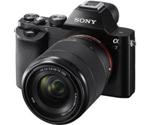
Sony Alpha 7S - Reviews
(3.7)
11 reviews
Info
Reviewbucket.co.uk scanned the internet for Sony Alpha 7S reviews.
You can find all Sony Alpha 7S reviews and ratings on this page.
Analysis
For Sony Alpha 7S, 11 customer reviews collected from 1 e-commerce sites, and the average score is 3.7.
Detailed seller stats;
Amazon has 11 customer reviews and the average score is 3.7. Go to this seller.
Detail
Similar Items
The reviews of this camera on Amazon are quite brief, so I thought I would put together a more detailed one. Overall I think it is a really good camera, but there are some very inflated claims for its abilities, and it doesn’t quite live up to all the hype. To be honest, I would forgive some of its shortcomings if it were priced a little bit lower, but considering what other cameras are available in this price-range, I would recommend thinking very carefully before buying one of these.I seem to be a bit unusual in that I bought this camera for still photography and not for video. It is very good for video, but I am not a skilled videographer so probably not the best person to review it on that dimension.
Pros:• Very detailed out of the box 1080P video at full-frame 35mm sensor size so you get much shallower depth of field than standard film super 35mm size. It makes the 5D2 and 5D3 video look like SD because of how good it is. It's up there with C300 detail.• Very beautiful stills. There's just something about the quality of them that looks really good. Some reviewers online have said they have a medium format quality to them. That might be because of the great dynamic range. Low shadow noise maybe.•Silent shutter is an amazing feature.•Using just about any lens is a great selling point.•Small raw file sizes for stills is actually a breath of fresh air.•Incredible dynamic range in stills and video (especially with Slog2)• The king of low light for video.
I have had this camera for about a year and it is superb. I rarely use it for video - it has no in body stabilisation and even if the quality is superb, it isn't smooth unless mounted in a tripod. My Oly EM1 is loads better on video with its 5 axis stabilisation....albeit it doesn't do 4K.The focus is fast and reliable even in almost complete darkness. The ISO is useable up to about 80,000. I use the camera mainly for astro photography where it excels. No problems whatsoever starting ISO at 3,200 when night shooting and even 6,400 for star shots.The real value of the super high ISO is to frame your shots when you simply can't see in complete darkness. My friend,
